Sustainable Marketing Strategies of Icebreaker: A Report
VerifiedAdded on 2023/01/03
|10
|2512
|93
Report
AI Summary
This report provides an in-depth analysis of Icebreaker's sustainable marketing principles and practices. It begins with an introduction to Icebreaker's background, emphasizing its commitment to natural fibers and ethical business practices. The report outlines key sustainable marketing principles, including green, social, and critical marketing, and examines how Icebreaker integrates these into its product development, pricing, distribution, and promotional strategies. A detailed case analysis, incorporating theories of sustainable marketing, is presented, focusing on Icebreaker's product range, pricing strategies, distribution channels, and promotional campaigns. The report also assesses Icebreaker's market positioning, competitive advantages, and the effectiveness of its strategies. The report concludes by highlighting Icebreaker's success in aligning its brand with customer values, ethical choices, and environmental stewardship, suggesting that such a commitment has boosted brand loyalty and facilitated growth. The analysis underscores the importance of genuine environmental commitment and innovation in achieving long-term success in the apparel industry.
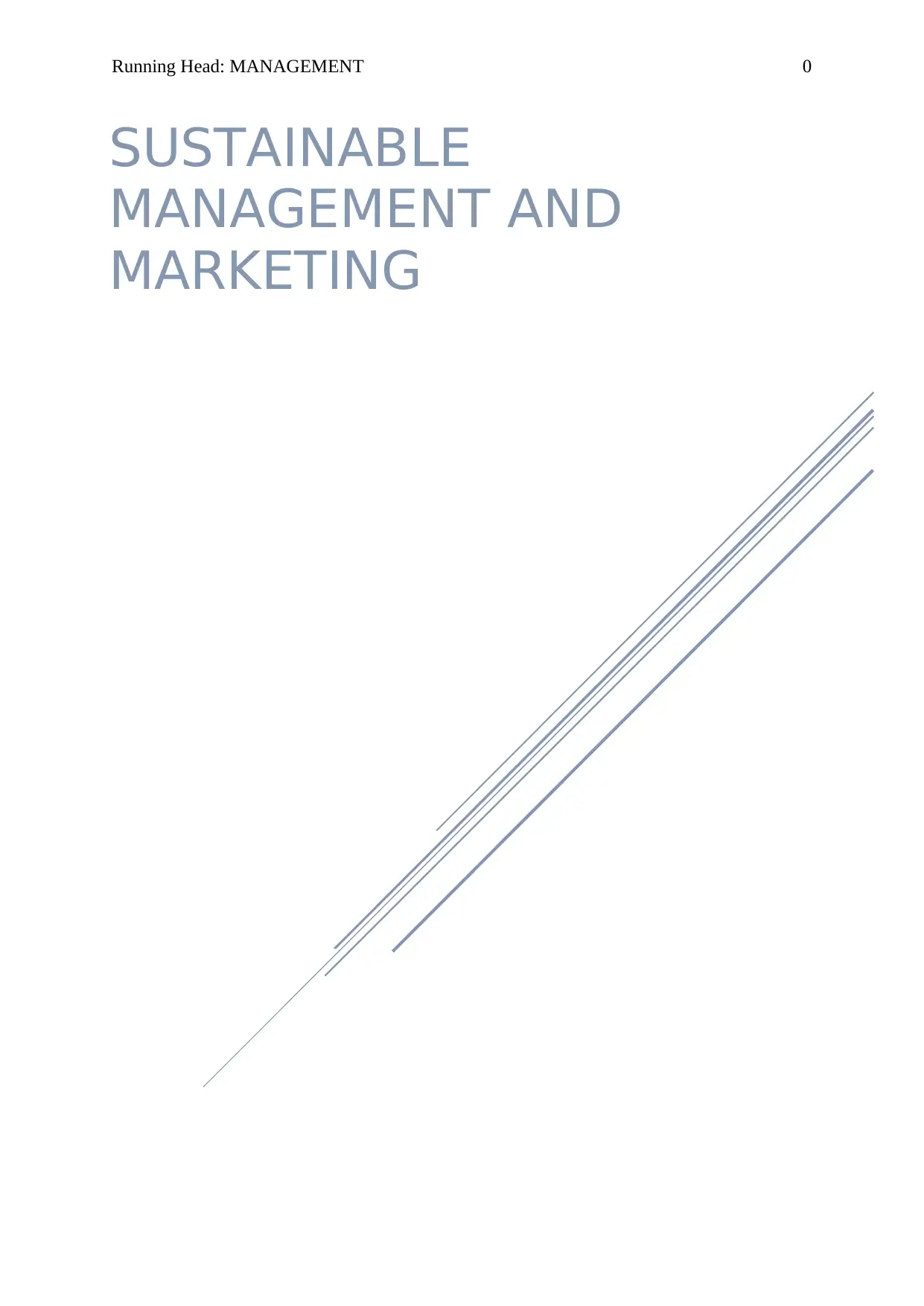
Running Head: MANAGEMENT 0
SUSTAINABLE
MANAGEMENT AND
MARKETING
SUSTAINABLE
MANAGEMENT AND
MARKETING
Paraphrase This Document
Need a fresh take? Get an instant paraphrase of this document with our AI Paraphraser
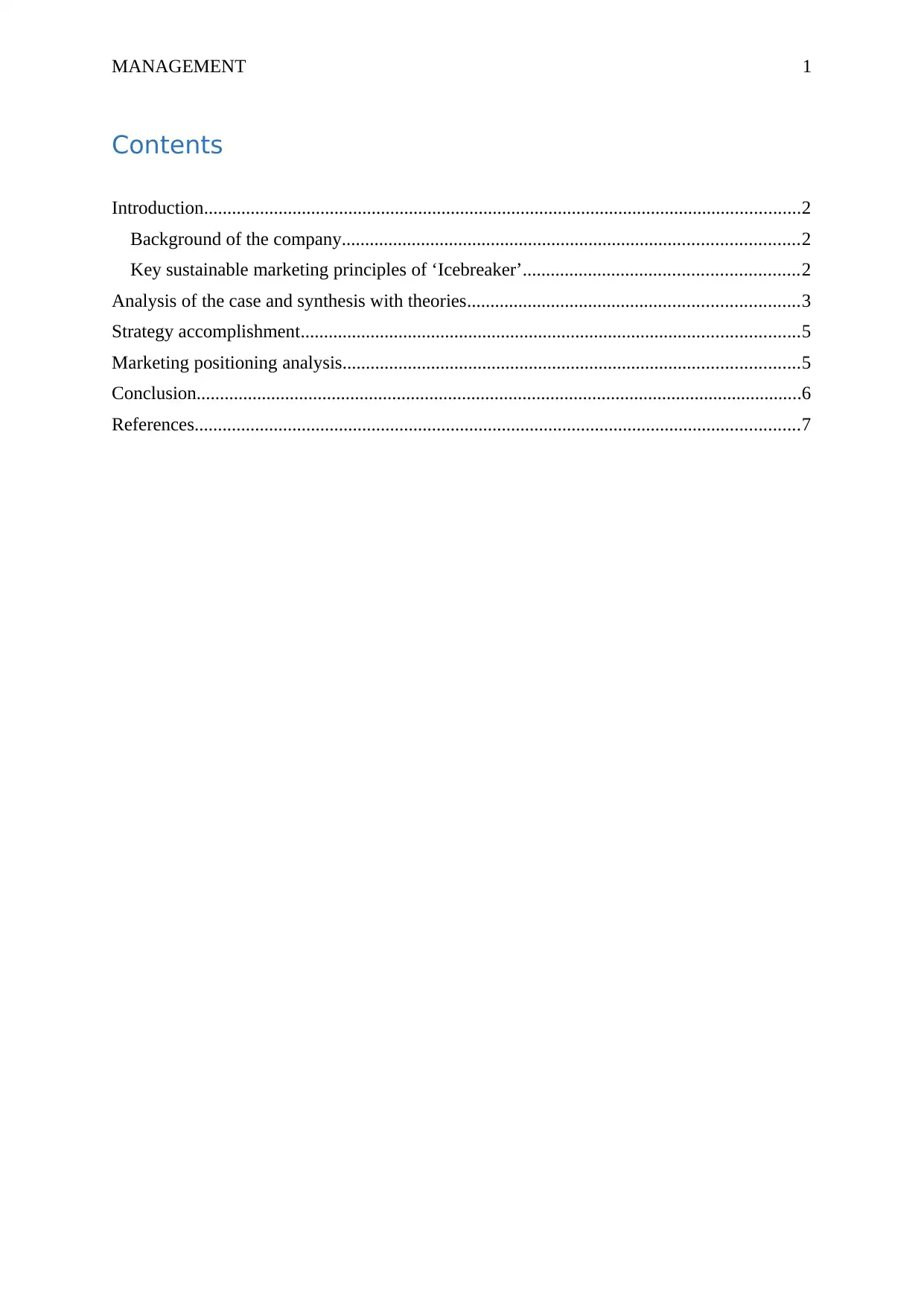
MANAGEMENT 1
Contents
Introduction................................................................................................................................2
Background of the company..................................................................................................2
Key sustainable marketing principles of ‘Icebreaker’...........................................................2
Analysis of the case and synthesis with theories.......................................................................3
Strategy accomplishment...........................................................................................................5
Marketing positioning analysis..................................................................................................5
Conclusion..................................................................................................................................6
References..................................................................................................................................7
Contents
Introduction................................................................................................................................2
Background of the company..................................................................................................2
Key sustainable marketing principles of ‘Icebreaker’...........................................................2
Analysis of the case and synthesis with theories.......................................................................3
Strategy accomplishment...........................................................................................................5
Marketing positioning analysis..................................................................................................5
Conclusion..................................................................................................................................6
References..................................................................................................................................7
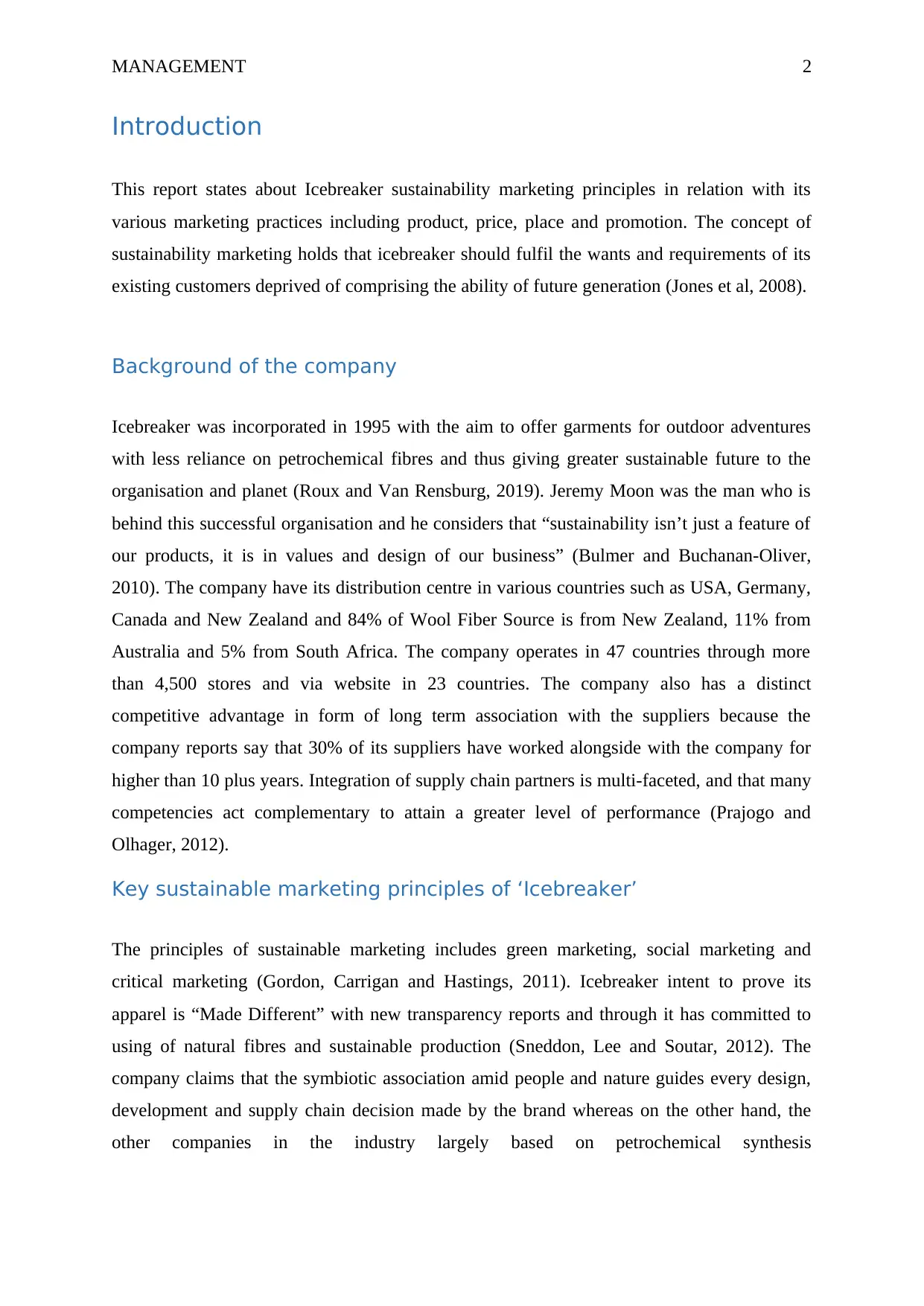
MANAGEMENT 2
Introduction
This report states about Icebreaker sustainability marketing principles in relation with its
various marketing practices including product, price, place and promotion. The concept of
sustainability marketing holds that icebreaker should fulfil the wants and requirements of its
existing customers deprived of comprising the ability of future generation (Jones et al, 2008).
Background of the company
Icebreaker was incorporated in 1995 with the aim to offer garments for outdoor adventures
with less reliance on petrochemical fibres and thus giving greater sustainable future to the
organisation and planet (Roux and Van Rensburg, 2019). Jeremy Moon was the man who is
behind this successful organisation and he considers that “sustainability isn’t just a feature of
our products, it is in values and design of our business” (Bulmer and Buchanan-Oliver,
2010). The company have its distribution centre in various countries such as USA, Germany,
Canada and New Zealand and 84% of Wool Fiber Source is from New Zealand, 11% from
Australia and 5% from South Africa. The company operates in 47 countries through more
than 4,500 stores and via website in 23 countries. The company also has a distinct
competitive advantage in form of long term association with the suppliers because the
company reports say that 30% of its suppliers have worked alongside with the company for
higher than 10 plus years. Integration of supply chain partners is multi-faceted, and that many
competencies act complementary to attain a greater level of performance (Prajogo and
Olhager, 2012).
Key sustainable marketing principles of ‘Icebreaker’
The principles of sustainable marketing includes green marketing, social marketing and
critical marketing (Gordon, Carrigan and Hastings, 2011). Icebreaker intent to prove its
apparel is “Made Different” with new transparency reports and through it has committed to
using of natural fibres and sustainable production (Sneddon, Lee and Soutar, 2012). The
company claims that the symbiotic association amid people and nature guides every design,
development and supply chain decision made by the brand whereas on the other hand, the
other companies in the industry largely based on petrochemical synthesis
Introduction
This report states about Icebreaker sustainability marketing principles in relation with its
various marketing practices including product, price, place and promotion. The concept of
sustainability marketing holds that icebreaker should fulfil the wants and requirements of its
existing customers deprived of comprising the ability of future generation (Jones et al, 2008).
Background of the company
Icebreaker was incorporated in 1995 with the aim to offer garments for outdoor adventures
with less reliance on petrochemical fibres and thus giving greater sustainable future to the
organisation and planet (Roux and Van Rensburg, 2019). Jeremy Moon was the man who is
behind this successful organisation and he considers that “sustainability isn’t just a feature of
our products, it is in values and design of our business” (Bulmer and Buchanan-Oliver,
2010). The company have its distribution centre in various countries such as USA, Germany,
Canada and New Zealand and 84% of Wool Fiber Source is from New Zealand, 11% from
Australia and 5% from South Africa. The company operates in 47 countries through more
than 4,500 stores and via website in 23 countries. The company also has a distinct
competitive advantage in form of long term association with the suppliers because the
company reports say that 30% of its suppliers have worked alongside with the company for
higher than 10 plus years. Integration of supply chain partners is multi-faceted, and that many
competencies act complementary to attain a greater level of performance (Prajogo and
Olhager, 2012).
Key sustainable marketing principles of ‘Icebreaker’
The principles of sustainable marketing includes green marketing, social marketing and
critical marketing (Gordon, Carrigan and Hastings, 2011). Icebreaker intent to prove its
apparel is “Made Different” with new transparency reports and through it has committed to
using of natural fibres and sustainable production (Sneddon, Lee and Soutar, 2012). The
company claims that the symbiotic association amid people and nature guides every design,
development and supply chain decision made by the brand whereas on the other hand, the
other companies in the industry largely based on petrochemical synthesis
⊘ This is a preview!⊘
Do you want full access?
Subscribe today to unlock all pages.

Trusted by 1+ million students worldwide
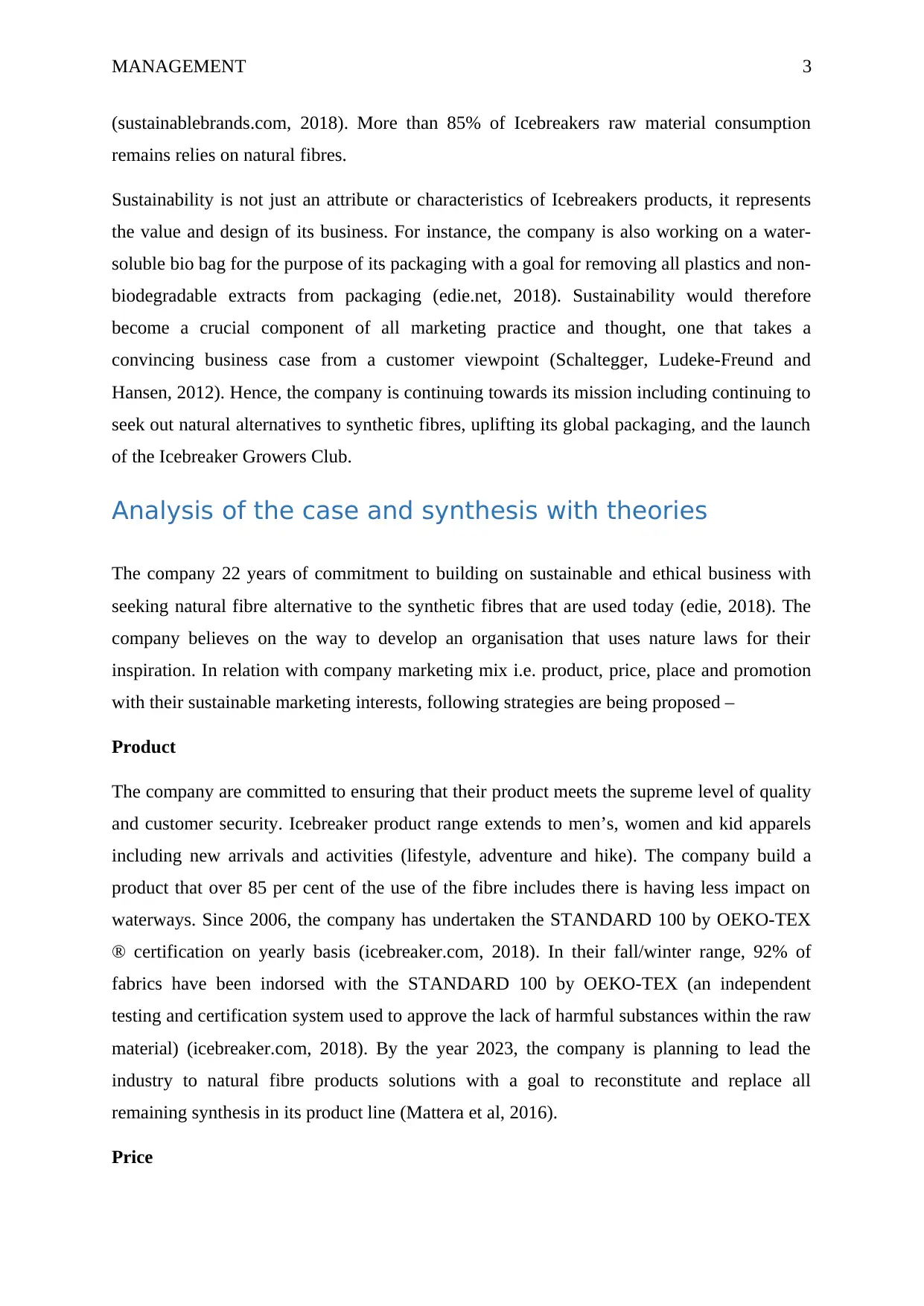
MANAGEMENT 3
(sustainablebrands.com, 2018). More than 85% of Icebreakers raw material consumption
remains relies on natural fibres.
Sustainability is not just an attribute or characteristics of Icebreakers products, it represents
the value and design of its business. For instance, the company is also working on a water-
soluble bio bag for the purpose of its packaging with a goal for removing all plastics and non-
biodegradable extracts from packaging (edie.net, 2018). Sustainability would therefore
become a crucial component of all marketing practice and thought, one that takes a
convincing business case from a customer viewpoint (Schaltegger, Ludeke-Freund and
Hansen, 2012). Hence, the company is continuing towards its mission including continuing to
seek out natural alternatives to synthetic fibres, uplifting its global packaging, and the launch
of the Icebreaker Growers Club.
Analysis of the case and synthesis with theories
The company 22 years of commitment to building on sustainable and ethical business with
seeking natural fibre alternative to the synthetic fibres that are used today (edie, 2018). The
company believes on the way to develop an organisation that uses nature laws for their
inspiration. In relation with company marketing mix i.e. product, price, place and promotion
with their sustainable marketing interests, following strategies are being proposed –
Product
The company are committed to ensuring that their product meets the supreme level of quality
and customer security. Icebreaker product range extends to men’s, women and kid apparels
including new arrivals and activities (lifestyle, adventure and hike). The company build a
product that over 85 per cent of the use of the fibre includes there is having less impact on
waterways. Since 2006, the company has undertaken the STANDARD 100 by OEKO-TEX
® certification on yearly basis (icebreaker.com, 2018). In their fall/winter range, 92% of
fabrics have been indorsed with the STANDARD 100 by OEKO-TEX (an independent
testing and certification system used to approve the lack of harmful substances within the raw
material) (icebreaker.com, 2018). By the year 2023, the company is planning to lead the
industry to natural fibre products solutions with a goal to reconstitute and replace all
remaining synthesis in its product line (Mattera et al, 2016).
Price
(sustainablebrands.com, 2018). More than 85% of Icebreakers raw material consumption
remains relies on natural fibres.
Sustainability is not just an attribute or characteristics of Icebreakers products, it represents
the value and design of its business. For instance, the company is also working on a water-
soluble bio bag for the purpose of its packaging with a goal for removing all plastics and non-
biodegradable extracts from packaging (edie.net, 2018). Sustainability would therefore
become a crucial component of all marketing practice and thought, one that takes a
convincing business case from a customer viewpoint (Schaltegger, Ludeke-Freund and
Hansen, 2012). Hence, the company is continuing towards its mission including continuing to
seek out natural alternatives to synthetic fibres, uplifting its global packaging, and the launch
of the Icebreaker Growers Club.
Analysis of the case and synthesis with theories
The company 22 years of commitment to building on sustainable and ethical business with
seeking natural fibre alternative to the synthetic fibres that are used today (edie, 2018). The
company believes on the way to develop an organisation that uses nature laws for their
inspiration. In relation with company marketing mix i.e. product, price, place and promotion
with their sustainable marketing interests, following strategies are being proposed –
Product
The company are committed to ensuring that their product meets the supreme level of quality
and customer security. Icebreaker product range extends to men’s, women and kid apparels
including new arrivals and activities (lifestyle, adventure and hike). The company build a
product that over 85 per cent of the use of the fibre includes there is having less impact on
waterways. Since 2006, the company has undertaken the STANDARD 100 by OEKO-TEX
® certification on yearly basis (icebreaker.com, 2018). In their fall/winter range, 92% of
fabrics have been indorsed with the STANDARD 100 by OEKO-TEX (an independent
testing and certification system used to approve the lack of harmful substances within the raw
material) (icebreaker.com, 2018). By the year 2023, the company is planning to lead the
industry to natural fibre products solutions with a goal to reconstitute and replace all
remaining synthesis in its product line (Mattera et al, 2016).
Price
Paraphrase This Document
Need a fresh take? Get an instant paraphrase of this document with our AI Paraphraser
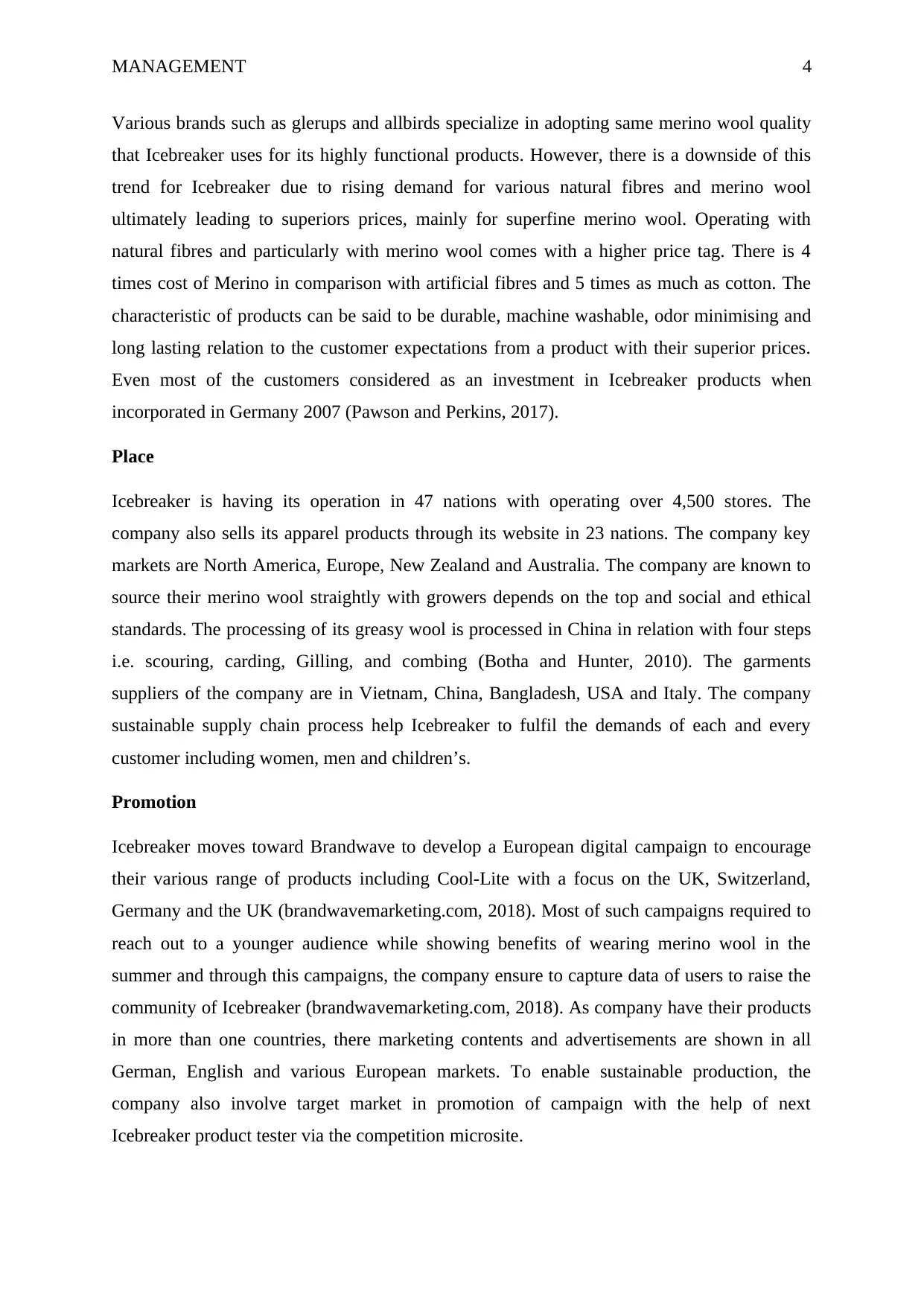
MANAGEMENT 4
Various brands such as glerups and allbirds specialize in adopting same merino wool quality
that Icebreaker uses for its highly functional products. However, there is a downside of this
trend for Icebreaker due to rising demand for various natural fibres and merino wool
ultimately leading to superiors prices, mainly for superfine merino wool. Operating with
natural fibres and particularly with merino wool comes with a higher price tag. There is 4
times cost of Merino in comparison with artificial fibres and 5 times as much as cotton. The
characteristic of products can be said to be durable, machine washable, odor minimising and
long lasting relation to the customer expectations from a product with their superior prices.
Even most of the customers considered as an investment in Icebreaker products when
incorporated in Germany 2007 (Pawson and Perkins, 2017).
Place
Icebreaker is having its operation in 47 nations with operating over 4,500 stores. The
company also sells its apparel products through its website in 23 nations. The company key
markets are North America, Europe, New Zealand and Australia. The company are known to
source their merino wool straightly with growers depends on the top and social and ethical
standards. The processing of its greasy wool is processed in China in relation with four steps
i.e. scouring, carding, Gilling, and combing (Botha and Hunter, 2010). The garments
suppliers of the company are in Vietnam, China, Bangladesh, USA and Italy. The company
sustainable supply chain process help Icebreaker to fulfil the demands of each and every
customer including women, men and children’s.
Promotion
Icebreaker moves toward Brandwave to develop a European digital campaign to encourage
their various range of products including Cool-Lite with a focus on the UK, Switzerland,
Germany and the UK (brandwavemarketing.com, 2018). Most of such campaigns required to
reach out to a younger audience while showing benefits of wearing merino wool in the
summer and through this campaigns, the company ensure to capture data of users to raise the
community of Icebreaker (brandwavemarketing.com, 2018). As company have their products
in more than one countries, there marketing contents and advertisements are shown in all
German, English and various European markets. To enable sustainable production, the
company also involve target market in promotion of campaign with the help of next
Icebreaker product tester via the competition microsite.
Various brands such as glerups and allbirds specialize in adopting same merino wool quality
that Icebreaker uses for its highly functional products. However, there is a downside of this
trend for Icebreaker due to rising demand for various natural fibres and merino wool
ultimately leading to superiors prices, mainly for superfine merino wool. Operating with
natural fibres and particularly with merino wool comes with a higher price tag. There is 4
times cost of Merino in comparison with artificial fibres and 5 times as much as cotton. The
characteristic of products can be said to be durable, machine washable, odor minimising and
long lasting relation to the customer expectations from a product with their superior prices.
Even most of the customers considered as an investment in Icebreaker products when
incorporated in Germany 2007 (Pawson and Perkins, 2017).
Place
Icebreaker is having its operation in 47 nations with operating over 4,500 stores. The
company also sells its apparel products through its website in 23 nations. The company key
markets are North America, Europe, New Zealand and Australia. The company are known to
source their merino wool straightly with growers depends on the top and social and ethical
standards. The processing of its greasy wool is processed in China in relation with four steps
i.e. scouring, carding, Gilling, and combing (Botha and Hunter, 2010). The garments
suppliers of the company are in Vietnam, China, Bangladesh, USA and Italy. The company
sustainable supply chain process help Icebreaker to fulfil the demands of each and every
customer including women, men and children’s.
Promotion
Icebreaker moves toward Brandwave to develop a European digital campaign to encourage
their various range of products including Cool-Lite with a focus on the UK, Switzerland,
Germany and the UK (brandwavemarketing.com, 2018). Most of such campaigns required to
reach out to a younger audience while showing benefits of wearing merino wool in the
summer and through this campaigns, the company ensure to capture data of users to raise the
community of Icebreaker (brandwavemarketing.com, 2018). As company have their products
in more than one countries, there marketing contents and advertisements are shown in all
German, English and various European markets. To enable sustainable production, the
company also involve target market in promotion of campaign with the help of next
Icebreaker product tester via the competition microsite.

MANAGEMENT 5
⊘ This is a preview!⊘
Do you want full access?
Subscribe today to unlock all pages.

Trusted by 1+ million students worldwide
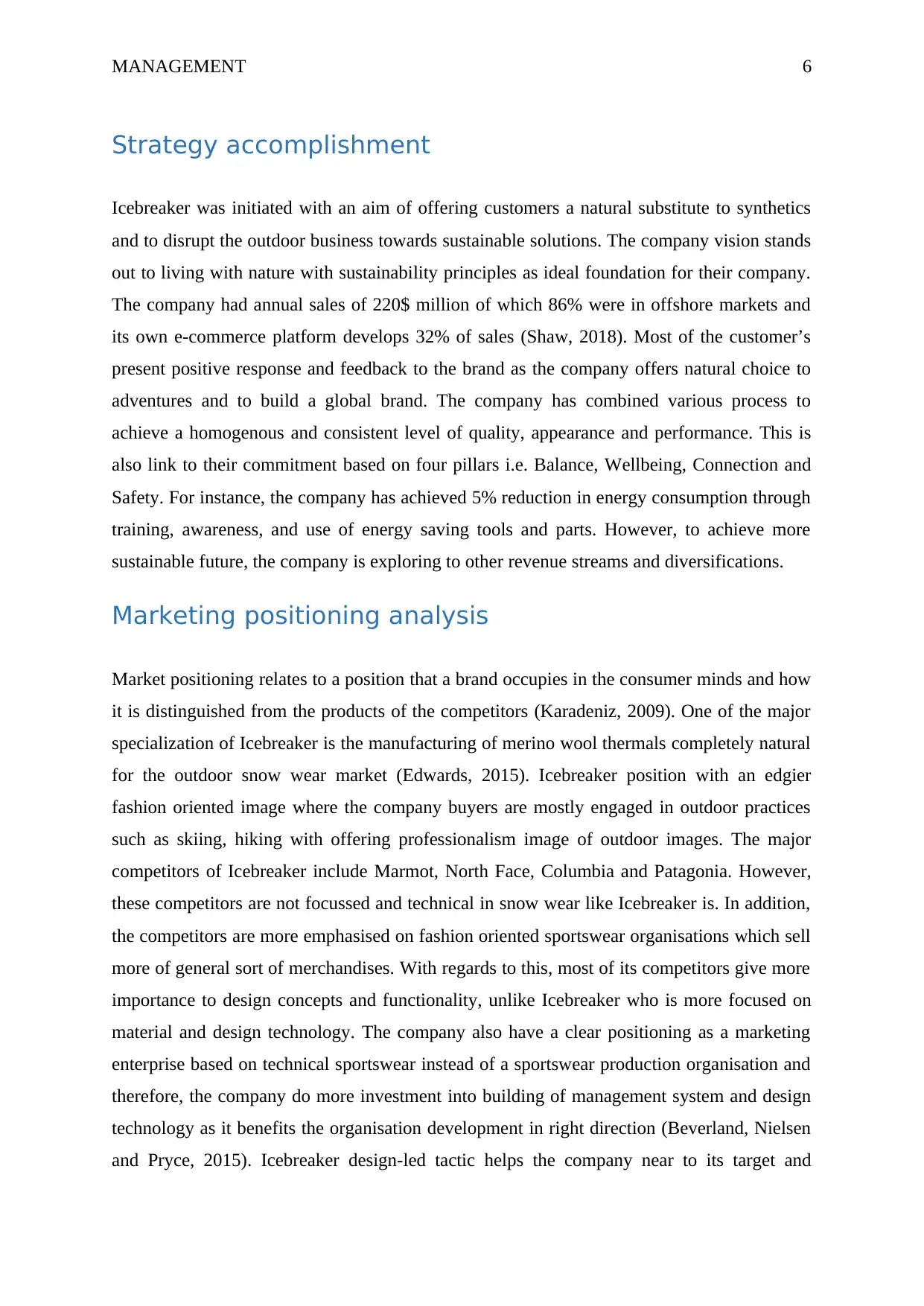
MANAGEMENT 6
Strategy accomplishment
Icebreaker was initiated with an aim of offering customers a natural substitute to synthetics
and to disrupt the outdoor business towards sustainable solutions. The company vision stands
out to living with nature with sustainability principles as ideal foundation for their company.
The company had annual sales of 220$ million of which 86% were in offshore markets and
its own e-commerce platform develops 32% of sales (Shaw, 2018). Most of the customer’s
present positive response and feedback to the brand as the company offers natural choice to
adventures and to build a global brand. The company has combined various process to
achieve a homogenous and consistent level of quality, appearance and performance. This is
also link to their commitment based on four pillars i.e. Balance, Wellbeing, Connection and
Safety. For instance, the company has achieved 5% reduction in energy consumption through
training, awareness, and use of energy saving tools and parts. However, to achieve more
sustainable future, the company is exploring to other revenue streams and diversifications.
Marketing positioning analysis
Market positioning relates to a position that a brand occupies in the consumer minds and how
it is distinguished from the products of the competitors (Karadeniz, 2009). One of the major
specialization of Icebreaker is the manufacturing of merino wool thermals completely natural
for the outdoor snow wear market (Edwards, 2015). Icebreaker position with an edgier
fashion oriented image where the company buyers are mostly engaged in outdoor practices
such as skiing, hiking with offering professionalism image of outdoor images. The major
competitors of Icebreaker include Marmot, North Face, Columbia and Patagonia. However,
these competitors are not focussed and technical in snow wear like Icebreaker is. In addition,
the competitors are more emphasised on fashion oriented sportswear organisations which sell
more of general sort of merchandises. With regards to this, most of its competitors give more
importance to design concepts and functionality, unlike Icebreaker who is more focused on
material and design technology. The company also have a clear positioning as a marketing
enterprise based on technical sportswear instead of a sportswear production organisation and
therefore, the company do more investment into building of management system and design
technology as it benefits the organisation development in right direction (Beverland, Nielsen
and Pryce, 2015). Icebreaker design-led tactic helps the company near to its target and
Strategy accomplishment
Icebreaker was initiated with an aim of offering customers a natural substitute to synthetics
and to disrupt the outdoor business towards sustainable solutions. The company vision stands
out to living with nature with sustainability principles as ideal foundation for their company.
The company had annual sales of 220$ million of which 86% were in offshore markets and
its own e-commerce platform develops 32% of sales (Shaw, 2018). Most of the customer’s
present positive response and feedback to the brand as the company offers natural choice to
adventures and to build a global brand. The company has combined various process to
achieve a homogenous and consistent level of quality, appearance and performance. This is
also link to their commitment based on four pillars i.e. Balance, Wellbeing, Connection and
Safety. For instance, the company has achieved 5% reduction in energy consumption through
training, awareness, and use of energy saving tools and parts. However, to achieve more
sustainable future, the company is exploring to other revenue streams and diversifications.
Marketing positioning analysis
Market positioning relates to a position that a brand occupies in the consumer minds and how
it is distinguished from the products of the competitors (Karadeniz, 2009). One of the major
specialization of Icebreaker is the manufacturing of merino wool thermals completely natural
for the outdoor snow wear market (Edwards, 2015). Icebreaker position with an edgier
fashion oriented image where the company buyers are mostly engaged in outdoor practices
such as skiing, hiking with offering professionalism image of outdoor images. The major
competitors of Icebreaker include Marmot, North Face, Columbia and Patagonia. However,
these competitors are not focussed and technical in snow wear like Icebreaker is. In addition,
the competitors are more emphasised on fashion oriented sportswear organisations which sell
more of general sort of merchandises. With regards to this, most of its competitors give more
importance to design concepts and functionality, unlike Icebreaker who is more focused on
material and design technology. The company also have a clear positioning as a marketing
enterprise based on technical sportswear instead of a sportswear production organisation and
therefore, the company do more investment into building of management system and design
technology as it benefits the organisation development in right direction (Beverland, Nielsen
and Pryce, 2015). Icebreaker design-led tactic helps the company near to its target and
Paraphrase This Document
Need a fresh take? Get an instant paraphrase of this document with our AI Paraphraser
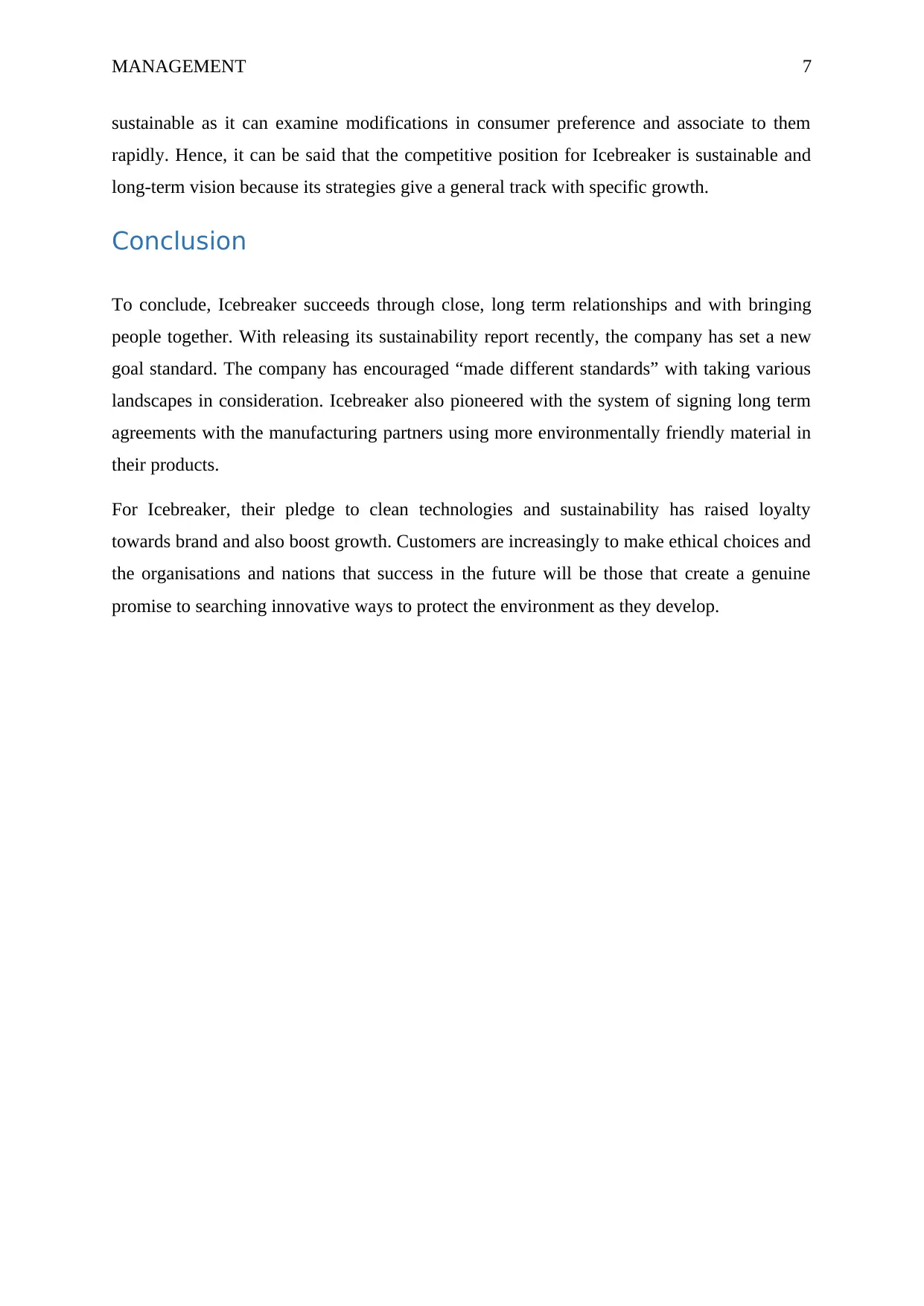
MANAGEMENT 7
sustainable as it can examine modifications in consumer preference and associate to them
rapidly. Hence, it can be said that the competitive position for Icebreaker is sustainable and
long-term vision because its strategies give a general track with specific growth.
Conclusion
To conclude, Icebreaker succeeds through close, long term relationships and with bringing
people together. With releasing its sustainability report recently, the company has set a new
goal standard. The company has encouraged “made different standards” with taking various
landscapes in consideration. Icebreaker also pioneered with the system of signing long term
agreements with the manufacturing partners using more environmentally friendly material in
their products.
For Icebreaker, their pledge to clean technologies and sustainability has raised loyalty
towards brand and also boost growth. Customers are increasingly to make ethical choices and
the organisations and nations that success in the future will be those that create a genuine
promise to searching innovative ways to protect the environment as they develop.
sustainable as it can examine modifications in consumer preference and associate to them
rapidly. Hence, it can be said that the competitive position for Icebreaker is sustainable and
long-term vision because its strategies give a general track with specific growth.
Conclusion
To conclude, Icebreaker succeeds through close, long term relationships and with bringing
people together. With releasing its sustainability report recently, the company has set a new
goal standard. The company has encouraged “made different standards” with taking various
landscapes in consideration. Icebreaker also pioneered with the system of signing long term
agreements with the manufacturing partners using more environmentally friendly material in
their products.
For Icebreaker, their pledge to clean technologies and sustainability has raised loyalty
towards brand and also boost growth. Customers are increasingly to make ethical choices and
the organisations and nations that success in the future will be those that create a genuine
promise to searching innovative ways to protect the environment as they develop.
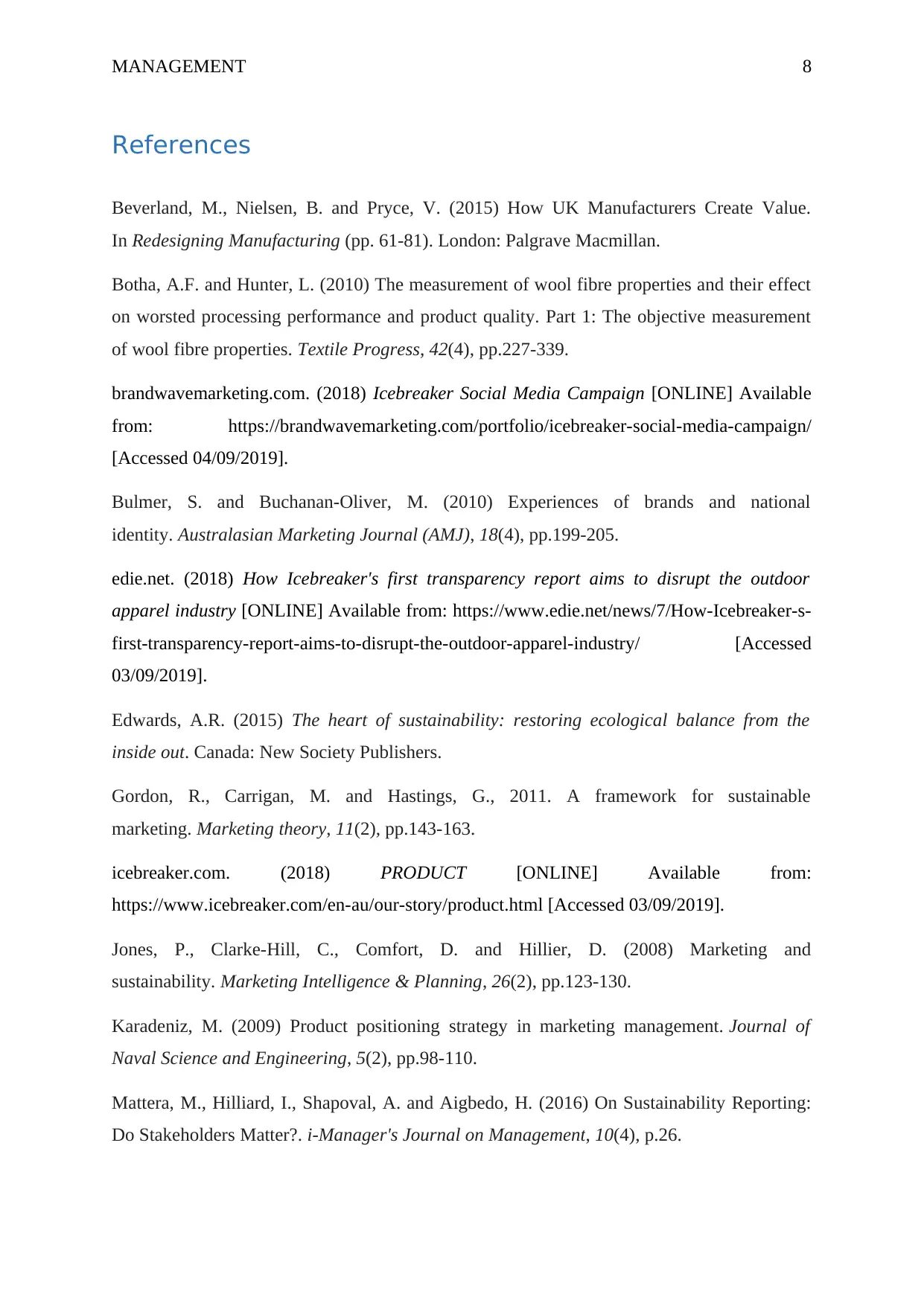
MANAGEMENT 8
References
Beverland, M., Nielsen, B. and Pryce, V. (2015) How UK Manufacturers Create Value.
In Redesigning Manufacturing (pp. 61-81). London: Palgrave Macmillan.
Botha, A.F. and Hunter, L. (2010) The measurement of wool fibre properties and their effect
on worsted processing performance and product quality. Part 1: The objective measurement
of wool fibre properties. Textile Progress, 42(4), pp.227-339.
brandwavemarketing.com. (2018) Icebreaker Social Media Campaign [ONLINE] Available
from: https://brandwavemarketing.com/portfolio/icebreaker-social-media-campaign/
[Accessed 04/09/2019].
Bulmer, S. and Buchanan-Oliver, M. (2010) Experiences of brands and national
identity. Australasian Marketing Journal (AMJ), 18(4), pp.199-205.
edie.net. (2018) How Icebreaker's first transparency report aims to disrupt the outdoor
apparel industry [ONLINE] Available from: https://www.edie.net/news/7/How-Icebreaker-s-
first-transparency-report-aims-to-disrupt-the-outdoor-apparel-industry/ [Accessed
03/09/2019].
Edwards, A.R. (2015) The heart of sustainability: restoring ecological balance from the
inside out. Canada: New Society Publishers.
Gordon, R., Carrigan, M. and Hastings, G., 2011. A framework for sustainable
marketing. Marketing theory, 11(2), pp.143-163.
icebreaker.com. (2018) PRODUCT [ONLINE] Available from:
https://www.icebreaker.com/en-au/our-story/product.html [Accessed 03/09/2019].
Jones, P., Clarke-Hill, C., Comfort, D. and Hillier, D. (2008) Marketing and
sustainability. Marketing Intelligence & Planning, 26(2), pp.123-130.
Karadeniz, M. (2009) Product positioning strategy in marketing management. Journal of
Naval Science and Engineering, 5(2), pp.98-110.
Mattera, M., Hilliard, I., Shapoval, A. and Aigbedo, H. (2016) On Sustainability Reporting:
Do Stakeholders Matter?. i-Manager's Journal on Management, 10(4), p.26.
References
Beverland, M., Nielsen, B. and Pryce, V. (2015) How UK Manufacturers Create Value.
In Redesigning Manufacturing (pp. 61-81). London: Palgrave Macmillan.
Botha, A.F. and Hunter, L. (2010) The measurement of wool fibre properties and their effect
on worsted processing performance and product quality. Part 1: The objective measurement
of wool fibre properties. Textile Progress, 42(4), pp.227-339.
brandwavemarketing.com. (2018) Icebreaker Social Media Campaign [ONLINE] Available
from: https://brandwavemarketing.com/portfolio/icebreaker-social-media-campaign/
[Accessed 04/09/2019].
Bulmer, S. and Buchanan-Oliver, M. (2010) Experiences of brands and national
identity. Australasian Marketing Journal (AMJ), 18(4), pp.199-205.
edie.net. (2018) How Icebreaker's first transparency report aims to disrupt the outdoor
apparel industry [ONLINE] Available from: https://www.edie.net/news/7/How-Icebreaker-s-
first-transparency-report-aims-to-disrupt-the-outdoor-apparel-industry/ [Accessed
03/09/2019].
Edwards, A.R. (2015) The heart of sustainability: restoring ecological balance from the
inside out. Canada: New Society Publishers.
Gordon, R., Carrigan, M. and Hastings, G., 2011. A framework for sustainable
marketing. Marketing theory, 11(2), pp.143-163.
icebreaker.com. (2018) PRODUCT [ONLINE] Available from:
https://www.icebreaker.com/en-au/our-story/product.html [Accessed 03/09/2019].
Jones, P., Clarke-Hill, C., Comfort, D. and Hillier, D. (2008) Marketing and
sustainability. Marketing Intelligence & Planning, 26(2), pp.123-130.
Karadeniz, M. (2009) Product positioning strategy in marketing management. Journal of
Naval Science and Engineering, 5(2), pp.98-110.
Mattera, M., Hilliard, I., Shapoval, A. and Aigbedo, H. (2016) On Sustainability Reporting:
Do Stakeholders Matter?. i-Manager's Journal on Management, 10(4), p.26.
⊘ This is a preview!⊘
Do you want full access?
Subscribe today to unlock all pages.

Trusted by 1+ million students worldwide
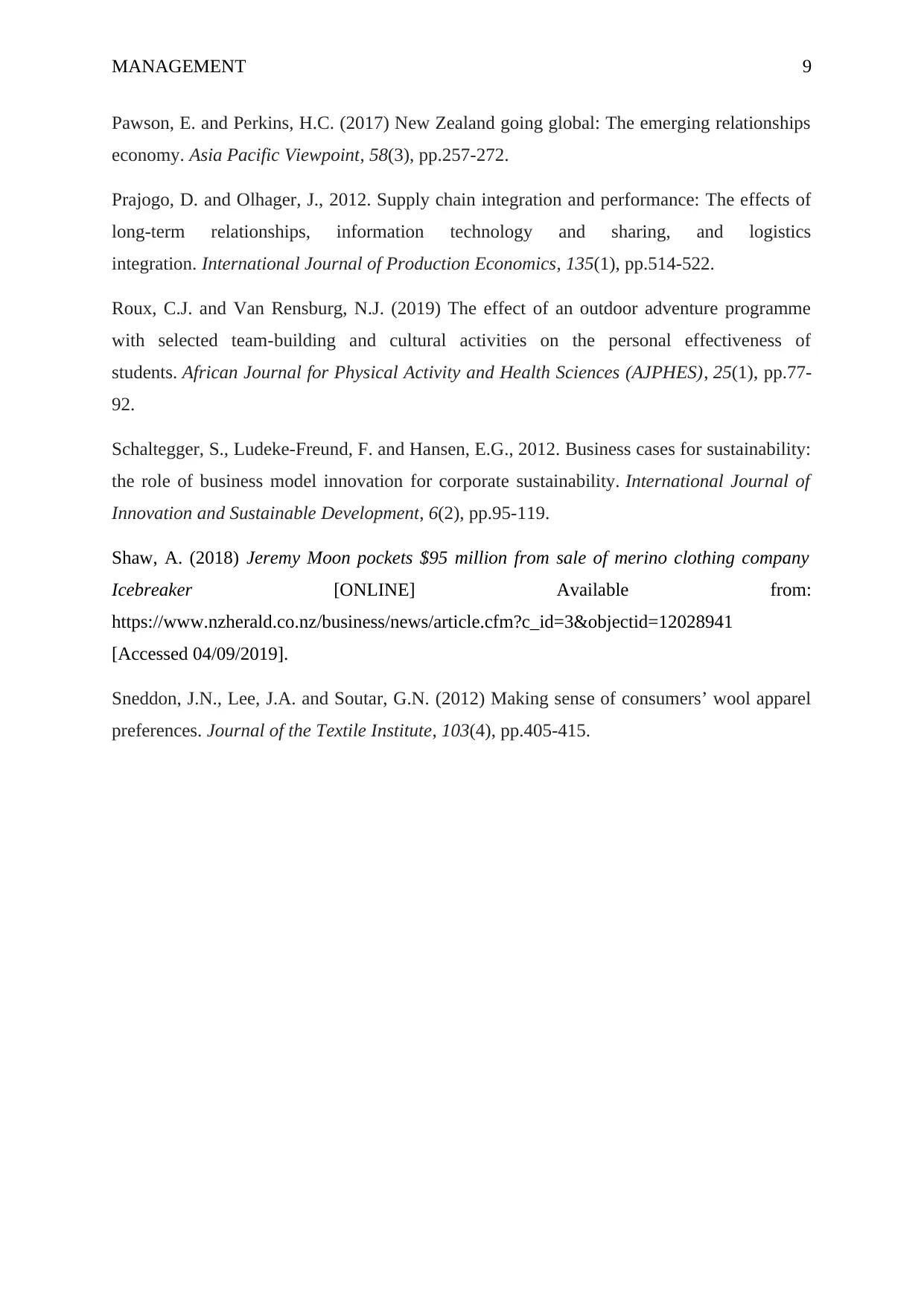
MANAGEMENT 9
Pawson, E. and Perkins, H.C. (2017) New Zealand going global: The emerging relationships
economy. Asia Pacific Viewpoint, 58(3), pp.257-272.
Prajogo, D. and Olhager, J., 2012. Supply chain integration and performance: The effects of
long-term relationships, information technology and sharing, and logistics
integration. International Journal of Production Economics, 135(1), pp.514-522.
Roux, C.J. and Van Rensburg, N.J. (2019) The effect of an outdoor adventure programme
with selected team-building and cultural activities on the personal effectiveness of
students. African Journal for Physical Activity and Health Sciences (AJPHES), 25(1), pp.77-
92.
Schaltegger, S., Ludeke-Freund, F. and Hansen, E.G., 2012. Business cases for sustainability:
the role of business model innovation for corporate sustainability. International Journal of
Innovation and Sustainable Development, 6(2), pp.95-119.
Shaw, A. (2018) Jeremy Moon pockets $95 million from sale of merino clothing company
Icebreaker [ONLINE] Available from:
https://www.nzherald.co.nz/business/news/article.cfm?c_id=3&objectid=12028941
[Accessed 04/09/2019].
Sneddon, J.N., Lee, J.A. and Soutar, G.N. (2012) Making sense of consumers’ wool apparel
preferences. Journal of the Textile Institute, 103(4), pp.405-415.
Pawson, E. and Perkins, H.C. (2017) New Zealand going global: The emerging relationships
economy. Asia Pacific Viewpoint, 58(3), pp.257-272.
Prajogo, D. and Olhager, J., 2012. Supply chain integration and performance: The effects of
long-term relationships, information technology and sharing, and logistics
integration. International Journal of Production Economics, 135(1), pp.514-522.
Roux, C.J. and Van Rensburg, N.J. (2019) The effect of an outdoor adventure programme
with selected team-building and cultural activities on the personal effectiveness of
students. African Journal for Physical Activity and Health Sciences (AJPHES), 25(1), pp.77-
92.
Schaltegger, S., Ludeke-Freund, F. and Hansen, E.G., 2012. Business cases for sustainability:
the role of business model innovation for corporate sustainability. International Journal of
Innovation and Sustainable Development, 6(2), pp.95-119.
Shaw, A. (2018) Jeremy Moon pockets $95 million from sale of merino clothing company
Icebreaker [ONLINE] Available from:
https://www.nzherald.co.nz/business/news/article.cfm?c_id=3&objectid=12028941
[Accessed 04/09/2019].
Sneddon, J.N., Lee, J.A. and Soutar, G.N. (2012) Making sense of consumers’ wool apparel
preferences. Journal of the Textile Institute, 103(4), pp.405-415.
1 out of 10
Related Documents
Your All-in-One AI-Powered Toolkit for Academic Success.
+13062052269
info@desklib.com
Available 24*7 on WhatsApp / Email
![[object Object]](/_next/static/media/star-bottom.7253800d.svg)
Unlock your academic potential
Copyright © 2020–2025 A2Z Services. All Rights Reserved. Developed and managed by ZUCOL.





